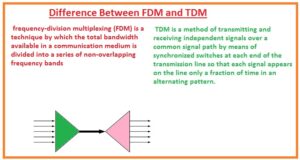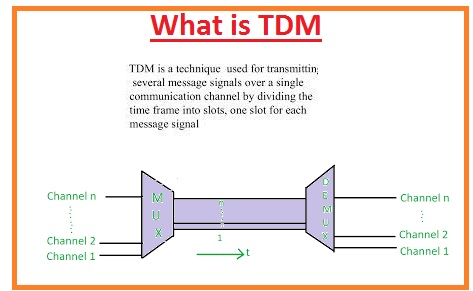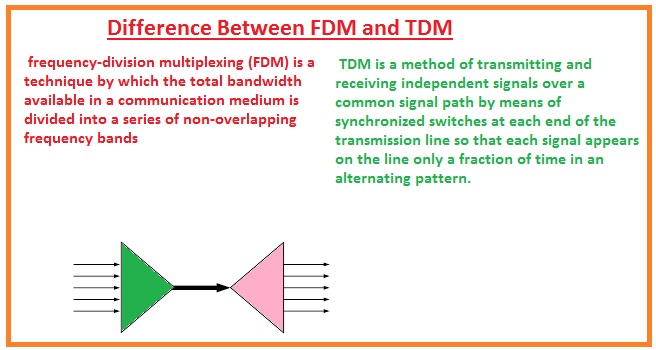 Hello, friends, I hope you all are doing great. In today’s tutorial, we will discuss the Difference Between FDM and TDM. There are 2 commonly used techniques for multiplexing and the first one is TDM and the second one is TDM. The basic difference between them is that in FDM numerous signals are transferred with different frequency slots. While in TDM signals are transferred through different time slots.
Hello, friends, I hope you all are doing great. In today’s tutorial, we will discuss the Difference Between FDM and TDM. There are 2 commonly used techniques for multiplexing and the first one is TDM and the second one is TDM. The basic difference between them is that in FDM numerous signals are transferred with different frequency slots. While in TDM signals are transferred through different time slots.
Multiplexing is a technique through which numerous signal is transmitted in a common channel. In today’s post, we will have a detailed look at both FDM and TDM to compare them and find their differences. So let’s get started with Difference Between FDM and TDM.
Difference Between FDM and TDM
FDM
- It is the method through which the net bandwidth of a single is parted in different frequency levels and every band has its on signal.
- It helps to convert a single medium used for transmission to make different mediums.
- It sends data in parallel combination
- The practical example of this method is radio signal transmission and tv transmission.
- There is cable tv is also an example through which numerous channels are operated.
- It uses analog multiplexing techniques.
- It does not need any synchronization.
- Its circuit arrangement is complicated.
- There is crosstalk is existing.
- In a telephone system, it is used to transmit calls over multiple users.
- There is a similar technique to this called wavelength division multiplexing that uses optic fiber for communication
- The full form of FDM is Frequency Division Multiplexing.
- Its propagating delay is sensitive.
- Its efficiency is less.
- Its price is high.
TDM
- The method that allows the transmission of numerous signals of data through the common line in different time slots is called TDM.
- Its full form is Time Division Multiplexing.
- It is a digital technique that operates on the time in place of frequency to distinguish data from another form of data.
- It is used to transmit 2 or more two signals through a single source.
- It is employed when the bit ratio of the signal source is larger than the signal sent.
- It was the first time used in the nineteenth century for telegraphy.
- It required synchronization.
- Its circuit is less complicated than the FDM.
- In this signal transmission, there is no need for crosstalk.
- Its efficiency is larger than the FDM.
- Its price is less than FDM.
- It is normally used for digital signal but also work for the analog signal
- In this module, the time domain is parted in different time slots having a certain value.
- In this signal transmission, a digital multiplexing technique is used.
- It has two types
Synchronous TDM
Asynchronous TDM
Synchronous TDM vs Asynchronous TDM
| Feature | Synchronous TDM | Asynchronous TDM |
|---|---|---|
| Timing | All slots are synchronized with common clock signals | Every slot is independent and nonsynchronized. |
| Slot allocation | Slots are allocated for certain time intervals | Slots are allocated on a first-come, first-served basis. |
| Overhead | it needs overhead for synchronization maintain | There is no need for overhead is required for synchronization. |
| Efficiency | It is best for high-bandwidth, continuous data streams. | it is good for bursty and intermittent data streams. |
| Example | T1 and E1 lines in telephony. | Ethernet LAN comes with many devices sharing a link. |
FDM vs TDM
| Feature | FDM | TDM |
|---|---|---|
| Basic principle | it divides the frequency bandwidth of the channel | It divides the time of the channel |
| Channel usage | Every signal uses a distinct frequency band | Every signal employs complete bandwidth in its turn. |
| Multiplexing | It is Frequency-division multiplexing. | It is Time-division multiplexing. |
| Demultiplexing | Every signal is separated through the use of a bandpass filter | In this module, every signal is separated through time slot allocation |
| Data rate | It can support high data rates | It is best for low to medium data rates |
| Efficiency | It is not effective since some bandwidth lost | It is efficient as the time slot is completely used |
| Overhead | It needs less overhead for synchronization. | It needs overhead for synchronization. |
| Application | The analog system such as radio and tv broadcasting | It is used in digital systems such as telephony and LANs. |
| The capacity | it supported larger users | Since it has time slot allocation so used for limited users. |
| Synchronization | It does not need signal transmission separately | Itg nee signals are transmitted in sequence |
| Complexity | It is less complicated since has separate frequency bands | It is completed due to time slot allocation |
| Cost | It can be costly due to the requirements of many bands | It is less costly due to the simple structure |
| Latency | It has less latency since signals are transmitted at the same time | It has high latency due to sequential transmission |
| Interference | Interference exists between different bands. | Interference can exist between different time slots. |
| Flexibility | it is not flexible as frequency bands are fixed | It is flexible as time slots can be allocated randomly |
| Resilience | It is resilient to channel noise and distortion | It is less resilient to channel noise and distortion |
| Examples | Its common examples are Analog broadcast systems like FM radio and TV. | Its examples are Digital telephony, ATM networks, and Ethernet. |
That is a detailed post about the difference between FDM and TDM if you have any queries ask in the comments. Thanks for reading. Have a good day.







